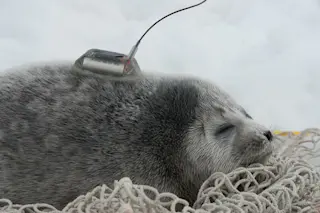A ringed seal pup outfitted with a satellite-linked transmitter just prior to being released as part of a project to understand the species' habitat ranges throughout the year. (Photograph: Michael Cameron/NOAA)
Editor's note: With the Arctic warming faster than any other region on Earth, floating sea ice in the region has been in decline: The average area of Arctic sea ice shrank at a rate of 57,000 square kilometers each year between 1996 and last year. That's an area slightly larger than the state of Michigan.
For the animals and other living things that manage to scrape a living in the harsh Arctic environment, you might think that this would be welcome new. And you'd be right — for some species, but most definitely not for others. As scientists learn more about the impacts of human-caused warming in the far north, they are gaining a clearer picture of both the ...














